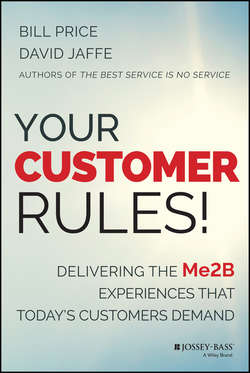Читать книгу Your Customer Rules! - Bill Price - Страница 7
На сайте Литреса книга снята с продажи.
Chapter One
From B2C to Me2B
What Used to Work, Doesn't Work Anymore
ОглавлениеSo what happened? Have our needs changed over the years, bringing customers and businesses out of sync? Or are companies today simply failing to deliver on the needs customers have always had?
Certainly, the landscape has changed. Today's businesses are bigger and incredibly more complex. Scale may have produced efficiency and economy, but it has distanced executives and management from their customers and from their frontline employees. Not only are businesses now headquartered in cities many miles from their customers, in an era of global operations the top executives may be in another country and speak another language. Senior management rarely spends time talking with customers, listening to their calls, or asking customer-facing staff for their take on what customers are saying. The bottom line is that scale has dissolved intimacy, and many organizations have forgotten the importance of moments of truth that required one-to-one interaction and connection.
Adding even more complexity, today's customer service operations have many moving parts that don't communicate with each other. The range of interaction channels, such as contact centers, SMS, co-browsing, the Internet, and social media, has proliferated. The net result is the omni-channel dilemma. While customers have clamored for new ways to deal with organizations, for example, via text messaging to take advantage of their always-at-hand smart phone, and while organizations have pressed ahead to open new channels, few of these channels have been integrated. This only increases customer frustration – and on top of that, support costs – a lose-lose scenario.
The Accenture Global Pulse, a study of customer attitude and behaviors across the world, reveals how frustrating this disconnect is for consumers.6 On a scale from 1 (“not frustrating at all”) to 5 (“extremely frustrating”), 23 percent of customers choose 4 and an incredible 66 percent choose 5 to describe their reaction to having to repeat the same information to multiple employees of a company or through multiple channels.
Customer relationship management (CRM), widely in practice today, is a flawed methodology that isn't working. Those who promoted it pushed technology solutions to control the relationship with customers. The very name customer relationship management reveals the heart of the problem. The organization should manage the relationship, the theory went. But customers were never asked if they wanted to be managed by organizations. And who would have asked to be managed? We'd argue that no one should manage a relationship; relationships are shared rather than managed. CRM has been flawed from the start, but is even more at odds with today's business climate.
The outcome of all this? Businesses continue to do stupid things that upset customers, like the ones captured in a U.K. survey: “Sending standard letters when I write an individual enquiry about something specific,” “They make everything so complicated,” and “Offering you the world when you're a potential customer and then treating you like crap when you're an existing customer.”7 Sound familiar?
6
Accenture. 2013. “Accenture 2013 Global Consumer Pulse Survey: Global & U.S. Key Findings.” Accessed May 20, 2014. http://www.accenture.com/SiteCollectionDocuments/PDF/Accenture-Global-Consumer-Pulse-Research-Study-2013-Key-Findings.pdf.
7
Cullum, Philip. 2006. The Stupid Company: How British Businesses Throw Away Money by Alienating Customers. National Consumer Council, p. 9.
